A knee sleeve is a type of compression garment designed to bolster the integrity of the knee joint.
Knee sleeves strengthen and protect this vital joint and, in doing so, facilitate exercise, prevent injury, and aid in recovery from injuries or surgery.
But the benefits don’t stop there.
Older individuals suffering from arthritic knees find knee sleeves help alleviate pain and promote mobility. For them, knee sleeves are a must-have item that adds immeasurably to the quality of their daily life.
Below, our health experts have brought together their choices for the 10 best knee sleeves of 2023.
Rankings
1. Crucial Compression Knee Sleeve
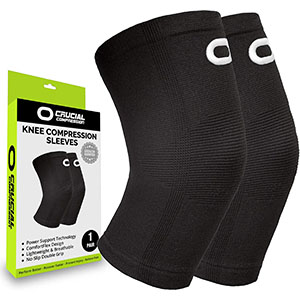
Click here for the lowest price on Amazon
If you’re looking for a simple, effective knee sleeve to protect your knee in the aftermath of an injury or to provide pain relief from arthritis, here it is. The Crucial Compression Knee Sleeve provides no-nonsense support, enhanced blood flow, and enable your active lifestyle.
What we like: We like how simple and effective these knee sleeves are. We like that they stay in place and do a good job retaining their compressibility. They’re a good choice for those recovering from injury or surgery.
Flaws: As mentioned these are fairly thick. So be aware they’ll likely be visible through your pants. They can also get pretty warm.
2. Mava Sports Knee Support Sleeves
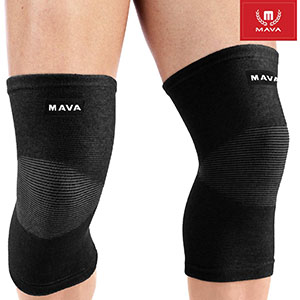
Click here for the lowest price on Amazon
Mava Sports Knee Support Sleeves are an excellent choice for physically active folks. They’re also a good choice for those with arthritic knees. They feel great from the minute you put them on, and that feeling doesn’t let up until you take them off.
What we like: We appreciate how comfortable and breathable these are. We also appreciate the all-around sense of support they provide. If you put a lot of repetitive stress on your knees these support sleeves from Mava Sports will help.
Flaws: These are long knee sleeves. That’s both their strong suit and a potential weakness. You may have to pull them up from time to time.
3. Powerlix Knee Compression Sleeve
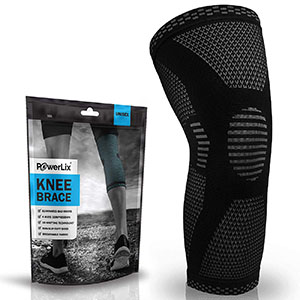
Click here for the lowest price on Amazon
A common complaint people have about knee sleeves is the tendency some have to slide down while you’re wearing them. That won’t happen with the Powerlix Knee Compression Sleeve. They’re kept in place by a pair of silicone gel strips at the top.
What we like: The silicone gel strips at the top work to hold these sleeves in place. We like that. These are also long knee sleeves, so they aid circulation more than some shorter sleeves do. We also like that they don’t irritate the skin and that they’re useful for people of all ages.
Flaws: As advertised, they do a good job absorbing sweat. That, however, means you’ll need to clean them pretty often. Also, because they’re long sizing can be an issue.
4. Scuddles Compression Knee Sleeve
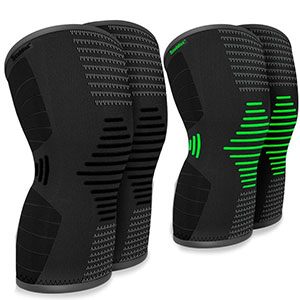
Click here for the lowest price on Amazon
Scuddles compression Knee Sleeves are simple in construction, compelling to look at, and extremely durable. They’re fashioned from a spandex/nylon weave that provides them with outstanding compressibility. They also boast the silicone gel strip that keeps them up all day.
What we like: They do a good job staying in place. They’re breathable on hot summer days and won’t cause irritation. They retain their compressibility even with regular use. They’re also easy to clean, attractive, and affordable.
Flaws: While it’s not terribly common, some people have an allergic reaction to neoprene, the material used to make these sleeves.
5. Bear KompleX Compression Knee Sleeves
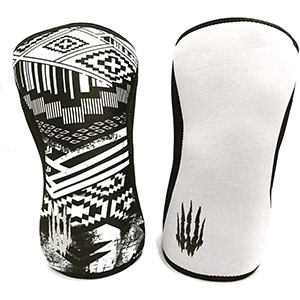
Click here for the lowest price on Amazon
Bear KompleX Compression Knee Sleeves are made specifically for the strength-training crowd. The weave grabs hold of the knee joint and keeps it on the straight and narrow. These are thick, tough, knee sleeves available in an array of colors and patterns for those who like to add a bit of fun to their workouts.
What we like: We like the firm hold and outstanding lateral stability they provide. The fact that they come in 5mm and 7mm thickness means they’re a solid choice for weight lifters of every age. They’re easy to clean and retain their compressibility well.
Flaws: They’re expensive and only available in various over-the-top designs. If you’re looking for something more restrained, you’re out of luck.
6. Athledict Knee Brace Compression Sleeve
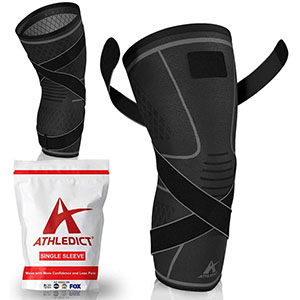
Click here for the lowest price on Amazon
Sometimes you need a bit more than the average knee sleeve can provide. But not something as involved as an actual knee brace. For times like that there’s the Athledict Knee Brace Compression Sleeve.
What we like: We like the integrated wrap-around strap that keeps them exactly where you need them for hours at a time. Being long they also help keep the blood flowing through the knee joint.
Flaws: The strap causes some people to conclude these are appropriate for heavy-duty Olympic-style lifting. They’re not.
7. McDavid Hex Knee Pads Compression Leg Sleeve
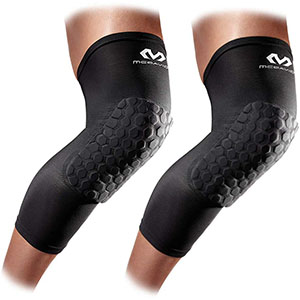
Click here for the lowest price on Amazon
If you’ve ever spent time in the CrossFit box, you know your knees can get pretty banged up. Even on the basketball court, knee-to-knee contact is often a painful fact of life. These Compression Leg Sleeves from McDavid come with integrated knee pads that help prevent patellar injuries.
What we like: They’re great for CrossFit enthusiasts, students of the martial arts and older folks who want a bit of extra protection against contact with the ground. They’re long and help promote circulation through the knee joint.
Flaws: They protect your knees from contact better than they protect themselves. So a few brushes with the pavement and the cover will begin to tear away from the knee pad.
8. Nordic Lifting Knee Sleeves
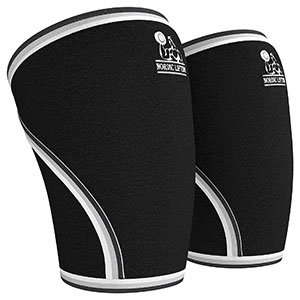
Click here for the lowest price on Amazon
The Nordic Lifting Knee Sleeves are thick and firm and help promote proper form whether you’re doing squats with a barbell or on the machine. Much to their credit, the manufacturer stands by their product with a 1-year replacement guarantee.
What we like: We like the job they do providing stability while lifting. We like how durable they are and that they tend to stay in place during your workout. We also appreciate that they don’t bunch up in the back when squatting.
Flaws: Sizing can sometimes be a tricky proposition. They’re also too thick for all-day use.
9. UFlex Athletics Knee Compression Sleeve
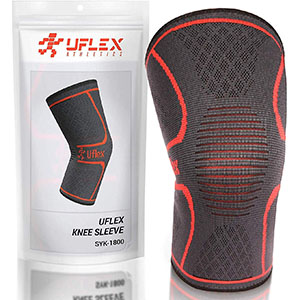
Click here for the lowest price on Amazon
The last of our best knee sleeves comes to us from UFlex Athletics. This is a simple, effective device that slips on easy and stays in place. Older folks with arthritic knees, younger folks engaged in CrossFit, and anyone in need of a bit of support through the knee will benefit from these durable, comfortable knee sleeves.
What we like: We like the support they provide while playing basketball, tennis and other sports. We also like that they can be worn for hours without causing much irritation. That makes them a good choice for everyone from bike riders to those with arthritic knees.
Flaws: Great protection during moderate exercise but not really made for heavy-duty weight lifting.
10. Mauwi Knee Sleeves for Men & Women
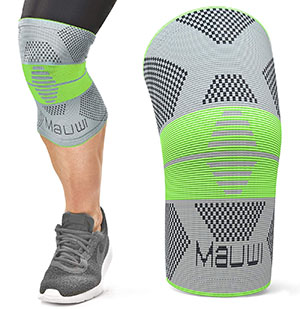
Click here for the lowest price on Amazon
Mauwi Knee Sleeves are made from a nylon/spandex weave that enables them to retain their compressibility for longer than many other brands. It also means they’re very comfortable and very effective. If you’ve had knee issues in the past you’ll find these a welcome addition to your everyday wear.
What we like: We like the way these sleeves take hold of the knee. We also like how breathable they are. Which makes them good sleeves for outdoor use. Build quality is excellent throughout and overall comfort is good to excellent.
Flaws: They’re not firm enough for Olympic-style weight lifting. They’re also short, so if they slide down just a little, you need to pull them back up.
Who Needs Knee Sleeves?
There are a wide range of people who could benefit from wearing knee sleeves. Starting, of course, with athletes or the athletically inclined. For instance, you’ll often see bike riders wearing them to ward off repetitive stress injuries.
Weight lifters are another group who would be wise to consider wearing knee sleeves. Especially those who practice Olympic weightlifting where massive amounts of weight are involved and the stresses on the knee joint can be great.
Older individuals who engage in strength training should also wear knee sleeves to bolster the structural integrity of their knees and prevent injury. And that’s true regardless of what type of lifting they’re doing.
In addition, many older folks suffer from osteoarthritis of the knee (1). This can be a very painful malady and one that can severely limit a person’s mobility. Knee sleeves can help these individuals by relieving pain and strengthening the knee.
Finally, knee sleeves are used by those in the process of recovering from knee injuries or knee surgery. In this regard, people often start out using the thickest, firmest type of knee sleeve and gradually work back to the thinnest over the course of their recovery.
How We Ranked
Knee sleeves are pretty simple items. Yet there are still surprising variations in quality to be found. And when you examine the many dozens of knee sleeves offered by various manufacturers, it quickly becomes apparent that some are worth the investment and some are not.
When selecting knee sleeves for our list we looked at things such as thickness. Any less than 3mm serves little or no useful purpose and is unlikely to last. If there was padding involved, we wanted to know if it was comfortable and durable. If the knee sleeves promised to facilitate a particular purpose, we tested to see if they fulfilled that promise.
Comfort was another concern. We eliminated any that were too tight or that lost their shape quickly while wearing them. And, of course, because these are compression garments, we wanted to see how effective they were and whether they retained their compressibility. Any that wound up quickly losing their elasticity did not make our list.
FAQs
Q: How do knee sleeves work?
A: Knee sleeves work by protecting the knee from injury or by helping the knee recover from injury or surgery. By buttressing the knee, they are also able to alleviate pain from osteoarthritis or rheumatoid arthritis of the knees. Essentially, the knee sleeve acts as an extra layer of connective tissue that wraps firmly around the knee joint holding it in place, promoting blood flow, absorbing shocks, and preventing unnatural movement.
Q: Are knee sleeves the same as knee braces?
A: Knee sleeves are not the same as knee braces. While knee sleeves can be rightly said to ‘brace’ the knee to some extent, an actual brace is a more heavy-duty appliance that typically includes a rigid framework. Knee braces are typically employed to provide stability to fundamentally unstable knee joints. They’re a kind of middle ground between a knee sleeve and a full-blown cast. People recovering from knee surgery may be required to use a knee brace for some time, before graduating to a knee sleeve as their recovery progresses.
Q: How thick should knee sleeves be?
A: 3mm thick sleeves are often used by older folks to provide a bit of support to the knee during everyday activities. If there are no particular knee ailments present, a 3mm knee sleeve can be useful for distance training or various endurance sports. 5mm sleeves are typically used by the average person engaged in less-than-extreme weight training. If a person has a history of knee problems, 5mm sleeves will allow them to exercise in safety while protecting re-injury. 7mm thick knee sleeves are usually reserved for those involved in powerlifting, i.e., squats, deadlifts, clean-and-jerk and the snatch. 7mm sleeves are also commonly prescribed during the early part of recovery from serious knee injury or knee replacement surgery (2).
Q: Should I always wear knee sleeves during weight training?
A: A growing number of seniors are engaged in weight training. And that’s a very good thing. Recent studies have shown beyond any doubt that weight training increases all-around strength and helps older individuals stay vital (3). But any type of strength training brings with it the threat of injury. So before a person dives headlong into weight training, they should make sure they’re properly prepared. And that means knee sleeves, among other things. Certainly, there’s no need to wear knee sleeves if you’re working on your biceps. But for any type of lifting that involves the knees you should be wearing knee sleeves. Especially squats and ‘Olympic’ lifting (4).
Q: Should a knee sleeve be really tight?
A: This is an issue that many find confusing. And that’s understandable. Knee sleeves, after all, are designed to buttress the structural integrity of the knee. That is their primary purpose. So it only follows that to do that, the knee sleeve would need to be tight. But there’s tight, and then there’s tight. Regardless of the reason you’re wearing the knee sleeve, it should never be so tight as to cause pain or discomfort. What you’re after is a firm hold. Not a tight squeeze. If you need extra buttressing, that should come from the thickness of the sleeve, not from making it super-tight.
Q: Can knee sleeves help with arthritis?
A: Yes, knee sleeves can help with arthritis (5). Knee sleeves not only help to reduce the pain associated with osteoarthritis of the knee, but they also help promote mobility. This is one of the primary benefits of knee sleeves for older individuals. If you have arthritis of the knee, you should ask your doctor about wearing a knee sleeve or knee sleeves. It could make the difference between being housebound and being active.
Q: Can knee sleeves be worn all day?
A: Knee sleeves can be worn all day, but there should be some compelling reason to do so. Most of the people who wear knee sleeves for long hours at a time are older folks who use them to help strengthen knees weakened by arthritis or wear and tear. Those recovering from serious knee injuries also tend to wear them for long stretches at a time. Chances are, however, if your doctor determines that you need full-time support for a weakened or otherwise compromised knee, they’ll recommend you wear a knee brace instead.
Q: Should knee sleeves be stiff or flexible?
A: The stiffness or flexibility of a knee depends mostly on why you are wearing it. If you are wearing it simply to provide a bit of stability to an arthritic knee, then it doesn’t have to be rigid. You can use a thinner, more flexible sleeve. If you’ve recently undergone knee replacement surgery or ACL surgery, you’ll probably want to start with a stiff knee sleeve and gradually work toward a thinner, more flexible sleeve. On the other hand, if you’re wearing it to protect your knees during powerlifting, the sleeve should be pretty thick and pretty stiff.
Q: Are knee sleeves for older folks the same as knee sleeves for everyone else?
A: Why people buy knee sleeves tends to change depending on whether one is discussing young adults or older adults. Most young adults use the knee sleeve to prevent injury during exercise. Older adults use knee sleeves for that purpose too. But they also use them as a mobility aid. That’s because they’re very effective in alleviating the pain of arthritic knees. That said, the knee sleeves themselves do not change. There are no ‘knee sleeves for young people’ or ‘knee sleeves for old people’, just knee sleeves.
Q: How long do knee sleeves last?
A: If you wear them every day to exercise, then you’ll likely need to replace them in a few months. If, on the other hand, you workout once or twice a week, they’ll probably last a couple of years. If you are using the knee sleeves every day to help stabilize an arthritic knee, then they should also last a year or two. That’s because you’re not subjecting them to the kind of stresses they’d experience in the gym. Lastly, if you buy the cheapest knee sleeves on the market just to save a few bucks chances are you’ll be buying more a couple of months down the road. Even if you only wear them occasionally.
Q: Are there any disadvantages to wearing knee sleeves?
A: Should you get the wrong size knee sleeve – say, one that’s too tight – or wear it improperly, it’s possible that you might do more harm than good to your leg or legs. Also, if you’re wearing the knee sleeve during strength training, it’s important to use proper technique. Essentially, you should never feel as though your knees are being pinched. You should never feel as though your circulation is being cut off. And you should never feel any type of pain when you put the knee sleeve on. If you do, you should take it off immediately.
Q: Can knee sleeves cause blood clots?
A: A blood clot – or more precisely Deep Vein Thrombosis or DVT (6) – is the result of poor circulation in the lower leg. This is a problem that dogs senior citizens (7) who tend to spend a disproportionate amount of time sitting rather than moving around. In fact, recent evidence suggests that fainting in the elderly may actually be the result of blood clots traveling to the lungs and interrupting airflow (8). But back to the original question. The answer is that knee sleeves should never be so tight as to restrict circulation. So a properly fitting knee sleeve should not in any way contribute to DVT.
Q: Are knee sleeves better than knee braces?
A: Knee sleeves aren’t necessarily better than knee braces or vise versa. They’re two different animals. When contemplating whether you should wear a knee brace or a knee sleeve, the only real question is, “Which one is appropriate to my situation?” In some cases, the answer will be a knee brace. In others, it will be a knee sleeve. If you have any doubts you should discuss the situation with your doctor before purchasing and wearing either a brace or a sleeve.
Q: What’s the right way to wash knee sleeves?
A: The right way to wash knee sleeves starts with handling them the right way. If your knee sleeves are sweaty after a hard workout, don’t throw them haphazardly into a gym bag. All that will do is give bacteria both the time and opportunity to take root and multiply. It will then be much harder than it has to be to clean your knee sleeves. That said, it’s likely your knee sleeves came with washing instructions. As long as you haven’t allowed them to become bacterial breeding grounds, these basic washing instructions should suffice (9).
Q: Can I still use knee sleeves if they’ve developed mold?
A: If mold and mildew have taken hold, try bringing a pot of water to a boil. Pour the hot water into a bucket and add 4 ounces of white vinegar. Drop the sleeves into this hot mixture and let them sit for 10-15 minutes. Remove them from the hot mixture using protective gloves and wring them out. Then throw them into the washing machine with your regular laundry. Always make sure to let them air dry.
Related Articles
Recap
Knee sleeves serve a variety of important and useful functions. Among other things, they protect the knee from the threat of injury during weightlifting, promote proper form during exercise, improve circulation, relieve pain, and enable older folks to retain their mobility. When you consider how simple, effective, and affordable they are, they’re an incredible value.
If you plan on adding strength training to your routine, you should invest in knee sleeves. If you suffer from arthritis of the knees, you should invest in knee sleeves. If you are recovering from knee surgery or a knee injury, you’ll want to use knee sleeves as well.
All of the knee sleeves on our list are high-quality products that have passed critical muster and perform as advertised. Use the information provided above to make sure you find the right knee sleeves to serve your particular purpose.
For cpoe.org’s #1 recommended knee sleeves, click here.

